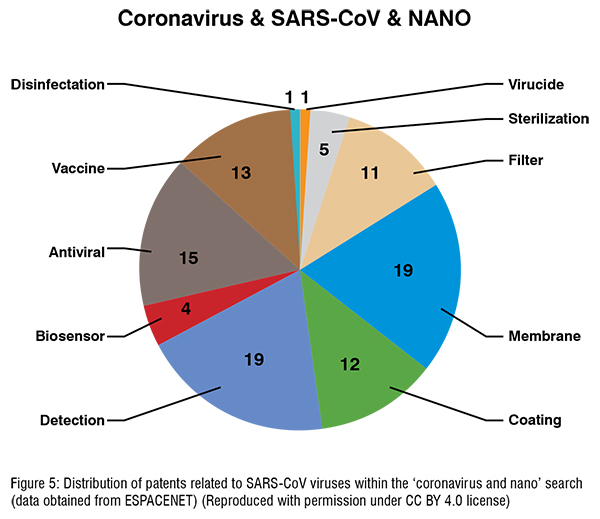Rapid viral outbreaks caused great inconvenience to mankind, especially since the last decade. The latest addition to the list is severe acute respiratory-related coronavirus 2 (SARSCoV-2) or more commonly Covid-19. As of 19 September 2020, this virus has a spread over 188 countries around the world, affected 30,500,368 people and caused 951,787 deaths. Nanotechnology and nanomaterials have an impressive record against viruses and capable to address many critical healthcare challenges that originated from the coronavirus pandemic.
Rapid viral outbreaks have caused great inconvenience to mankind, especially since the last decade. The latest addition to the list is severe acute respiratory-related coronavirus 2 (SARS-CoV-2) or more commonly COVID-19 (Figure 1). As of 19 September, 2020, this virus has a spread over 188 countries around the world, affected 30,500,368 people and caused 951,787 deaths. Nanotechnology and nanomaterials have an impressive record against viruses and they an address many critical healthcare challenges that originated from the coronavirus pandemic.
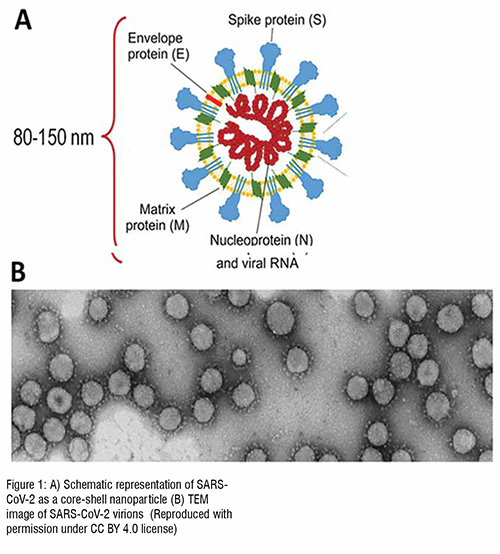
Nanomaterials can play various roles for the treatment of COVID-19 via the production of the vaccine, development of rapid point of care detection platform, synthesis of viral disinfectants, therapeutic nanomedicine etc (Figure 2).
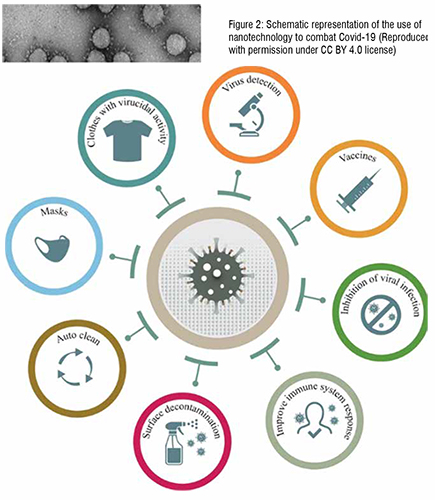
Regarding the development of the vaccine, a nanoparticle can be used as a nanocarrier to encapsulate the antigen payload to provide the required stability. Nanotechnology-based pathways also help to solve the challenges in vaccine delivery by guiding the vaccine to appropriate subcellular locations. There are many emerging nanotechnologies for the delivery of vaccines, for example, Moderna’s mRNA vaccine is based on a lipid nanoparticle platform and more such nanotechnology platforms including liposomes, cationic nanoemulsions, or polysaccharide particles are being used for guided delivery of mRNA based vaccines with improved stability. Moreover, nanotechnology- based vaccines can control premature degradation of antigens and facilitate sustained release, improved antigen stability, and offer targeted delivery of an immunogen, besides it can also increase the period of antigen exposure (Figure 3). According to a World Health Organization (WHO) report dated 17 September 2020, there are 36 candidate vaccines in clinical evaluation and 146 candidate vaccines are in preclinical evaluation. Among these, 16 vaccines are nanotechnology-based, and they are summarised in Table 1. As the interactions between nanoparticles and the immune system are rapidly explored, it can be anticipated that nanotechnology will deliver quicker, safer and more effective vaccines in comparison to those synthesised using conventional approaches.
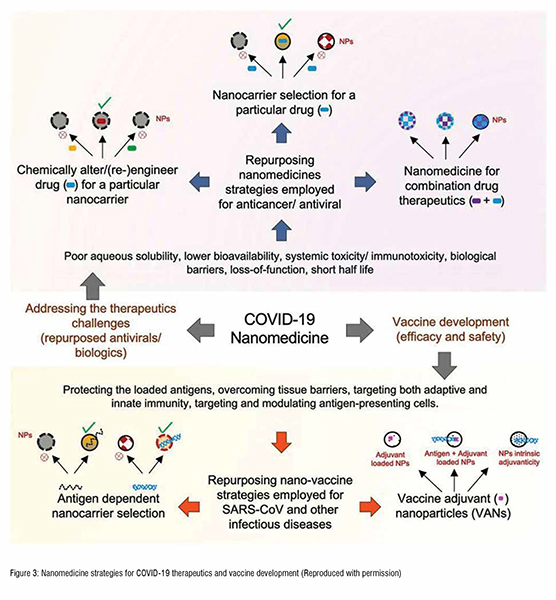
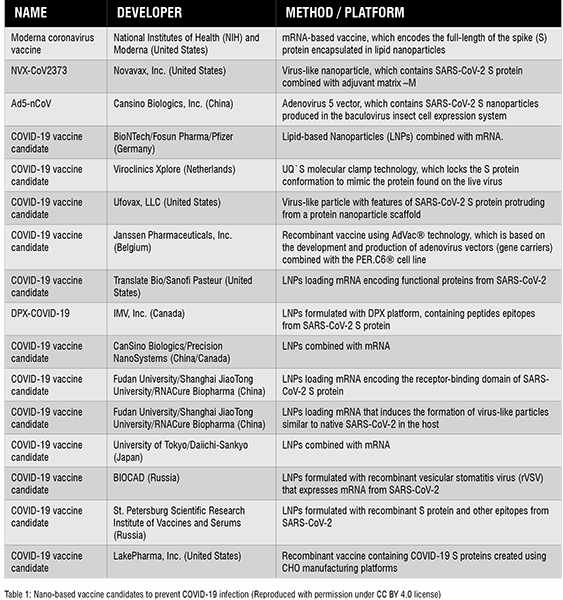
As of today, no vaccine has come in the market so currently there is a need for an inexpensive, rapid, point-of-care diagnostic test kit. A nanotechnology-based quick detection system has already been developed by Seo et al. using graphene-based Field-effect Transistor (FET) type biosensor (Figure 4). The sensor was synthesised by coating the graphene sheets of the FET with a specific antibody against SARSCoV-2 spike protein. The performance analysis was carried out employing nasopharyngeal swab specimens from COVID-19 patients, cultured virus and antigen protein. The biosensor could detect the SARS-CoV-2 spike protein at concentrations of 100 fg/mL in clinical transport medium and 1 fg/mL in phosphate-buffered saline. Moitra et al. developed a colourimetric assay based on gold nanoparticles for the detection of Covid-19 with bare eyes. Gold nanoparticles capped with thiol-modified antisense oligonucleotides specific for N-gene of SARS-CoV-2 could diagnose positive COVID-19 cases within 10 min from the isolated RNA samples. Qui et al. functionalised two-dimensional gold nanoislands with complementary DNA receptors and combined it with thermoplasmonic heat for insightful detection of the Covid-19 through nucleic acid hybridisation with a lower detection limit of 0.22 pM. Shan et al. used a breath device comprised of a nanomaterial-based hybrid sensor array having multiplexed detection capabilities to detect disease-specific biomarkers from exhaled breath, thereby enabling rapid and accurate diagnosis of Covid-19. Thus it can be believed that with the progress of time many more nanomaterial-based rapid diagnostic platforms will evolve to break the deadly transmission chain of the corona.
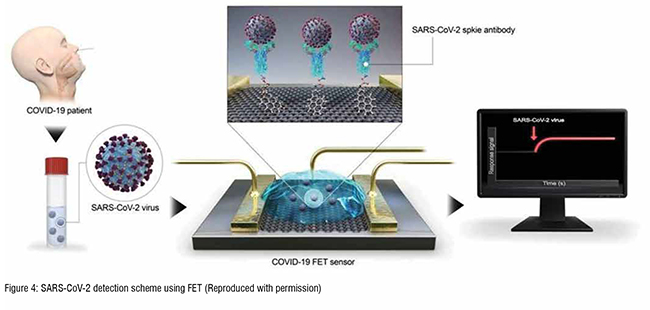
Coronavirus can be transmitted via various routes of (via cough or respiratory droplets, or biofluids), thus to combat the virus its dissemination must be prevented through disinfecting air, skin or surrounding surfaces. As surface disinfectants, nanoparticles can be used because of their inherent wide range antiviral activities, long stability and effectiveness at a lower dosage. Initial experiments revealed that silver nanocluster/silica composite coating had viricidal effects against SARS-CoV-2. Nanotech Surface, Italy has prepared a nanotechnology-based solution comprised of Titanium dioxide and silver which can act as surface disinfectant and surface will be selfsterilised for years. The silver nanoparticle is also used by Weinnovate Biosolutions, India and Defence Institute of Advanced Technology, India for the production of disinfectant to fight COVID 19 pandemic. FN nano, USA synthesised titanium dioxide nanoparticles based photocatalytic coating to destroy COVID-19 residing on the surface upon exposure to light. Scientists of the Queensland University of Technology has developed biodegradable anti-pollution mask using breathable nanocellulose material which can remove particles smaller than 100 nanometers. Zhong et al. deposited superhydrophobic graphene on temperature-sensitive surgical masks which can sterilise the surface viruses under solar illumination for long-term usage. One of this kind of mask is already been commercialised by LIGC Applications Ltd., USA.
Regarding the development of therapeutic nanomedicine for COVID-19, no success is achieved till now but it could be envisioned that the feasible result comes out in near future. Another interesting aspect is many nanotechnology-based patents have been filed aiming at the prevention of Covid-19 (Figure 5). This indicates the enormous application potential of nanotechnology to combat Covid-19. Finally, nanotechnology is a premium versatile tool which facilitates a variety of approaches and strategies that can contribute strongly to break the chain of transmission of this lethal infectious coronavirus disease.
